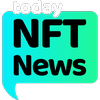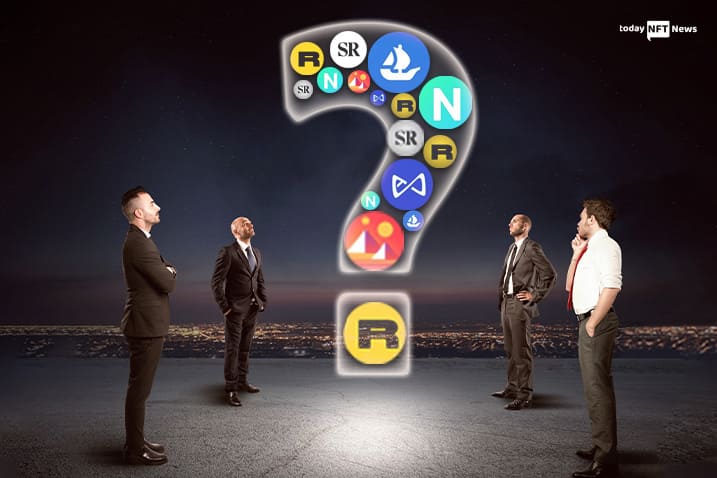Similar to any other physical market, an NFT marketplace is also a marketplace, but is digital in nature. Buyers and sellers can buy and sell any digital asset or Non-Fungible Token (NFT) in this marketplace. Furthermore, an NFT marketplace serves as a platform to display, store or create digital assets or NFT tokens.
A virtual economy platform, an NFT marketplace, runs on the peer-to-peer model. Having said that, artists can display as well as list their art like digital tokens and buyers can buy them in the form of an asset. All and all, it is the same as purchasing products online using the digital or E-wallet payment system.
Gaining popularity worldwide, an NFT marketplace holds special importance for celebrities and artists who have and who are making it big in the world of NFT space through some really popular and expensive NFTs.
Which blockchains are used in an NFT marketplace?
Numerous blockchains dominate the NFT world but ethereum remains the forever king. The #1 choice of many, it has transformed into the most talked about blockchain during the past year.
It is decentralized and offers financial & legal services required for transactions without depending on any intermediaries. One of the most crowded marketplaces at times, it houses some very famous NFT marketplaces like OpenSea, NFT artists like Beeple & Pak and NFT projects like BAYC and CryptoPunks.
Other popular blockchains in the NFT marketplace include:
Solana: This one is known to be among the fastest programmable blockchains. Blessed with a rare combination of proof-of-stake and proof-of-history consensus mechanisms, it discards the need for complicated puzzles. As a result, it has less validation times and fees.
Tezos: Those who have immense fondness for green alternatives can choose this blockchain. It uses a PoS consensus mechanism to curb the computational work that’s essential when it comes to verifying blocks and transactions on the blockchain. A great place to mint batches of NFTs or in other words, large-scale collections.
Flow: A high performance blockchain, Flow is geared towards the creation of games, NFTs and decentralized apps. It has been built keeping scalability in mind and is the host of NBA Top Shot. The blockchain can manage an excessively large amount of transactions and has low transaction fees.
Worldwide Asset Exchange (WAX): When it comes to virtual items and digital collectibles, no other blockchain is above WAX. It is known for digitized versions of legacy collectibles such as figurines, trading cards, memorabilia, etc. Furthermore, it is also host to powerful brands like NASCAR, Hot Wheels and film franchises like Godzilla and Spiderman.
Functionalities of NFT marketplace
Three major functionalities of the NFT world are- minting, buying and selling.
Minting an NFT means aiming to be the first owner of the product. In other words, it refers to purchasing an NFT directly from the group that creates it immediately after it is put on sale. Need not say, minting is a struggle in terms of popular projects.
One very important point to consider is having enough funds available which also includes the gas fees as it is incurred during the purchase.
Buying an NFT comes after being unlucky in minting the NFT and pulls towards the secondary marketplace.
Upon visiting the marketplaces, seeing the prices for individual NFTs is easy, which helps to find the NFT one likes and even discover new NFTs that are promising but were not found before. Downside here is the possibility of paying more than if the NFT would have been minted originally.
Once building out an NFT collection begins, there are high possibilities of some NFTs being worth more money. Another possibility is losing interest in them and looking for a buyer to offload them.
This brings one to selling the NFT, which begins with heading over to the marketplace the NFT was bought on, selecting the particular NFT and selling is the way.
The NFT has to be listed, mentioning a selling price and waiting for the right buyer. Fee is involved and during the first time, costs are involved as well.
Popular NFT marketplaces
Though there’s no end to NFT marketplaces, certain marketplaces are more popular than others and they all have valid reasons behind. In the giant NFT space, some of the leading NFT marketplaces include-
- OpenSea
- Axie Marketplace
- Larva Labs/CryptoPunks
- Rarible
- Nifty Gateway
- Mintable
- Foundation
- Theta Drop
- Crypto.com
- Binance
- SuperRare
- Decentraland
- Makersplace
How to find the best NFT marketplace?
Finding the best marketplace is a matter of patience, caution, ample time and a close look at some worthy factors as mentioned below-
Trading volume
To ensure the NFT platform fits the needs, it is very important to check if it has sufficient trading volumes for collectibles. For sellers, this is crucial to find ample users who are interested in buying NFTs as well as to sell NFTs to other traders.
Commission & transaction fees
Before the buying or selling of an NFT, blockchain processes a transaction as the network fee. Since most of the NFT marketplaces charge transaction fees that vary between 2.5% and 15% per sale, establishing what each NFT platform charges is necessary.
NFT collection
Both the NFT types and categories have grown largely in recent time. Before joining a marketplace, knowing the type of NFT one wants to buy or sell is important, as some platforms are particular in terms of NFTs they support.
NFT value & creators
Some marketplaces favor premium NFTs from popular celebrities or personalities; whereas, others allow anyone to mint as well as sell their work. This makes it important to find the marketplace that fits the NFTs one wants to collect based on the authorship of the token.
Blockchain
Transactions in an NFT marketplace are not possible without blockchain. Though most of the NFT platforms use ethereum, others work with networks like Polygon, Solana and Bitcoin. Certain NFT marketplaces provide cross-chain support to trade tokenized assets over the supported networks.
Considering these points, it is good to know which network an NFT marketplace belongs to, since it determines the cryptocurrency which can be used as well as which digital wallet to open to store it on.
Details regarding the NFT items
A reliable marketplace offers detailed information about the NFT items it lists in the offerings. The information includes the total number of NFTs in their catalog, number of bids, cost of each NFT, owner of each item, etc.
The availability of this information helps buyers make the right purchasing decisions. It also provides future sellers with the info that they can include to better market their creations.
Digital wallet
An NFT platform must offer support for a range of digital or crypto wallets as payment options. Checking which digital wallets are allowed by the NFT marketplace is required, especially if one has a crypto wallet open with one of the services.
Search & data features
When planning to buy or sell NFTs, people expect the marketplace to offer quick and correct data. A best marketplace is the one that offers search functions like looking for certain NFT names, cost of items and types or creators. Offering data visualization tools that help to understand the best NFTs investments is an added feature.
Gas fees
The gas fee refers to a fee charged for the energy consumed on transactions completed by users on the ethereum blockchain. Choosing an NFT marketplace that offers competitive gas fees is the wise move.
Security
Security of NFT transactions is foremost the most important factor to consider and must cover fraud protection, transaction insurance, advanced encryption, two-factor user authentication, etc.
Why is it good to store NFTs?
Protecting the NFTs is a major responsibility and needs caution as non-fungible tokens are digital assets and are a matter of hefty cost.
Nifty Gateway has faced incidents where digital artwork and credit card details were stolen from accounts. Also, several cryptocurrency fans have come across the term- ‘Not your crypto, not your keys,’ which means that they can’t own it if they do not have the private keys.
Cold storage wallets are the safest way to secure the NFTs because the sensitive data remains offline. Also, the data is password-protected, which acts as an extra layer of security.
These wallets have various features to offer unparalleled functionality to users. For instance, one of the features is the ability to restore the content of the device if it is stolen, lost or malfunctions.
Coming to the next perk, a cold storage wallet can be used as a hot wallet using the mobile connectivity of the device. Hence, one can look at the data and carry out transactions with utmost security.
How to create your own NFT marketplace?
It’s not uncommon to wish to build one’s own NFT marketplace. To do so, there are two ways- starting from the scratch or using the clone script of the preferred NFT marketplace.
To build it from the scratch, the basic steps to be followed are mentioned below:
- Choose the right blockchain
- Identify the audience
- Create a suitable user interface for the NFT marketplace
- Specify the operational domains
- Chose tokens
- Develop smart contracts
- Test and deploy the marketplace
Coming to the clone script option, it is an already made script that supports launching one’s own P2P NFT marketplace.
It’s a wrap!
And this was all about the NFT marketplace. Hopefully, the information enclosed here will serve your purpose and help you see answers to your questions or concerns.
Stay tuned with Today NFT News for more amazing information.
FAQs
Possessing an NFT doesn’t mean that it can be used in whatever way one wants to. Since it is not a currency, real things can’t be purchased by using it.
The NFT should be transferred to the marketplace where one intends to sell it, in case it is not there already or if the NFTs are being stored in the personal crypto wallet and can’t be viewed on a marketplace. Next, click on the ‘sell’ button from the NFT page one wants to sell.
NFT buyers are those who wish an expected return over a certain duration of time. They never buy things for material value. When an NFT is bought, the buyer gets a tokenized representation of the work and it is impossible to fabricate owing to the unique security properties of blockchains.
Launched in 2017, OpenSea is the largest NFT marketplace. Besides supporting multiple blockchains, it hosts various popular NFTs that include music, art, trading, photography, collectibles, GIFs, trading cards, in-game items and virtual worlds.
Everyone has their own reasons to buy NFTs. While some buy them with the belief that they will hold value in the future and consider it as an investment option, others buy NFTs to secure digital ownership of collectibles and physical assets besides accessing unique perks.
Investing in an NFT is easy and is all about the following steps:
· First things first, opening an account at an NFT marketplace is how the process begins.
· The second step involves creating a digital wallet to store the NFT keys as well as cryptocurrency tokens.
· Now comes the turn to fund the account. No matter if one uses an external wallet or a crypto exchange, connecting the bank account or credit card is required for transactions.
· Last but not the least, finding the NFT to buy is what needs to be done now. Thankfully, the NFT marketplace makes the process easy by assisting throughout the process. Prices of the NFTs range from inexpensive to millions of dollars. However, paying the transaction fees is mandatory.
After the purchase has been done or investment has been made, it can be accessed in the crypto wallet.



